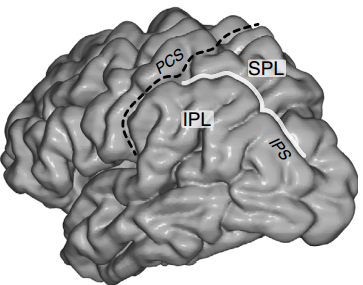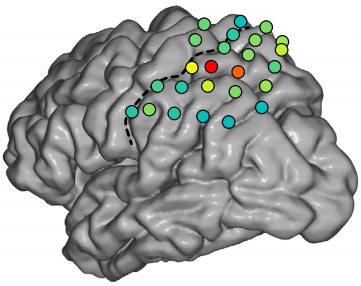Mathematical thinking area of brain identified; technique could lead to mind-reading devices, scientists say
October 18, 2013
[+]
Researchers have found
the first solid evidence that a specific brain region is activated in
everyday conversation when people use numbers (or even imprecise
quantitative terms, such as “more than”), according to a study by Stanford University School of Medicine scientists.
Intraparietal sulcus region of the brain (white line) (credit: Mohammad Dastjerdi et al./Nature Communications)
That brain region was previously found to be activated when people are asked to perform mathematical calculations, but only in a limited, unnatural experimental setting.
Those studies used either fMRI (subjects had to lie motionless inside a dark, tubular chamber whose silence is punctuated by constant, loud, mechanical, banging noises while images flashed on a computer screen) or EEG (imprecise).
Eavesdropping on the brain in real life
“This is not real life,” said Parvizi. “You’re not in your room, having a cup of tea and experiencing life’s events spontaneously.” A profoundly important question, he said, is: “How does a population of nerve cells that has been shown experimentally to be important in a particular function work in real life?”
“We’re now able to eavesdrop on the brain in real life,” said Josef Parvizi, MD, PhD, associate professor of neurology and neurological sciences and director of Stanford’s Human Intracranial Cognitive Electrophysiology Program. Parvizi is the senior author of the study, published Oct. 15 in Nature Communications (open access). The study’s lead authors are postdoctoral scholar Mohammad Dastjerdi, MD, PhD, and graduate student Muge Ozker.
The scientist speculate that this finding could lead to “mind-reading” applications that, for example, would allow a patient who is rendered mute by a stroke to communicate via passive thinking, or even more dystopian outcomes: chip implants that spy on or even control people’s thoughts — or just mathematical thinking in this case.
“This is exciting, and a little scary,” said Henry Greely, JD, the Deane F. and Kate Edelman Johnson Professor of Law and steering committee chair of the Stanford Center for Biomedical Ethics, who played no role in the study but is familiar with its contents. “It demonstrates, first, that we can see when someone’s dealing with numbers and, second, that we may conceivably someday be able to manipulate the brain to affect how someone deals with numbers.”
Any fears of impending mind control are, at a minimum, premature, said Greely. “Practically speaking, it’s not the simplest thing in the world to go around implanting electrodes in people’s brains. It will not be done tomorrow, or easily, or surreptitiously.”
Intracranial recording
[+]
The researchers monitored electrical activity in the intraparietal sulcus
(IPS) region of the brain, known to be important in attention and eye
and hand motion. Previous studies have hinted that some nerve-cell
clusters in this area are also involved in numerosity, the mathematical equivalent of literacy.
Recording
of patient neural responses in the IPS area. Red peaks show high neural
activity when the patient is thinking about numbers. (Credit: Stanford
University Medical Center)
His team’s method, called intracranial (within the skull) recording using electrocorticography (ECoG), provided exquisite anatomical and temporal precision and allowed the scientists to monitor brain activity when people were immersed in real-life situations. Parvizi and his associates tapped into the brains of three volunteers who were being evaluated for possible surgical treatment of their recurring, drug-resistant epileptic seizures.
The procedure involves temporarily removing a portion of a patient’s skull and positioning packets of electrodes against the exposed brain surface. For up to a week, patients remain hooked up to the monitoring apparatus while the electrodes pick up electrical activity within the brain.
This monitoring continues uninterrupted for patients’ entire hospital stay, capturing their inevitable repeated seizures and enabling neurologists to determine the exact spot in each patient’s brain where the seizures are originating.
During this whole time, patients remain tethered to the monitoring apparatus and mostly confined to their beds. But otherwise, except for the typical intrusions of a hospital setting, they are comfortable, free of pain and free to eat, drink, think, talk to friends and family in person or on the phone, or watch videos.
The electrodes implanted in patients’ heads are like wiretaps, each eavesdropping on a population of several hundred thousand nerve cells and reporting back to a computer. In the study, participants’ actions were also monitored by video cameras throughout their stay. This allowed the researchers later to correlate patients’ voluntary activities in a real-life setting with nerve-cell behavior in the monitored brain region.
As part of the study, volunteers answered true/false questions that popped up on a laptop screen, one after another. Some questions required calculation — for instance, is it true or false that 2+4=5? — while others demanded what scientists call episodic memory: true or false: I had coffee at breakfast this morning. In other instances, patients were simply asked to stare at the crosshairs at the center of an otherwise blank screen to capture the brain’s “resting state.”
Where quantitative thought is located
[+]
Consistent with other studies, Parvizi’s team found that electrical
activity in a particular group of nerve cells in the intraparietal
sulcus spiked when, and only when, volunteers were performing
calculations.
ECoG
responses during the experiment. Electrodes in red and orange areas
(located in the IPS region) showed activity only when volunteers were
performing calculations; other colored areas correspond to
non-mathematical thinking. (Credit: Mohammad Dastjerdi et al./Nature Communications)
Afterward, Parvizi and his colleagues analyzed each volunteer’s daily electrode record, identified many spikes in intraparietal-sulcus activity that occurred outside experimental settings, and turned to the recorded video footage to see exactly what the volunteer had been doing when such spikes occurred.
They found that when a patient mentioned a number — or even a quantitative reference, such as “some more,” “many,” or “bigger than the other one” — there was a spike of electrical activity in the same nerve-cell population of the intraparietal sulcus that was activated when the patient was doing calculations under experimental conditions.
That was an unexpected finding. “We found that this region is activated not only when reading numbers or thinking about them, but also when patients were referring more obliquely to quantities,” said Parvizi.
“These nerve cells are not firing chaotically,” he said. “They’re very specialized, active only when the subject starts thinking about numbers. When the subject is reminiscing, laughing or talking, they’re not activated.” Thus, it was possible to know, simply by consulting the electronic record of participants’ brain activity, whether they were engaged in quantitative thought during nonexperimental conditions.
The study was funded by the National Institutes of Health, the Stanford NeuroVentures Program, and the Gwen and Gordon Bell Family. Additional co-authors were postdoctoral scholar Brett Foster, PhD, and research assistant Vinitha Rangarajan. Information on Stanford Medicine’s Department of Neurology and Neurological Sciences, which also supported the work, is available at http://neurology.stanford.edu/.
Video of patient’s neural responses
Abstract of Nature Communications paper
Human cognition is traditionally studied in experimental conditions wherein confounding complexities of the natural environment are intentionally eliminated. Thus, it remains unknown how a brain region involved in a particular experimental condition is engaged in natural conditions. Here we use electrocorticography to address this uncertainty in three participants implanted with intracranial electrodes and identify activations of neuronal populations within the intraparietal sulcus region during an experimental arithmetic condition. In a subsequent analysis, we report that the same intraparietal sulcus neural populations are activated when participants, engaged in social conversations, refer to objects with numerical content. Our prototype approach provides a means for both exploring human brain dynamics as they unfold in complex social settings and reconstructing natural experiences from recorded brain signals.
(¯`*• Global Source and/or more resources at http://goo.gl/zvSV7 │ www.Future-Observatory.blogspot.com and on LinkeIn Group's "Becoming Aware of the Futures" at http://goo.gl/8qKBbK │ @SciCzar │ Point of Contact: www.linkedin.com/in/AndresAgostini
 Washington
Washington